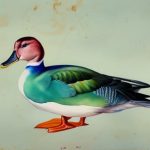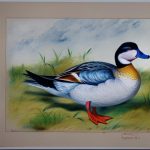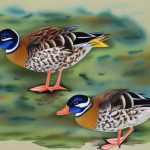Ducks have been a part of the British countryside for centuries, and the UK is home to a wide variety of duck breeds. While some breeds are well-known and commonly found on farms and in backyard flocks, there are also several rare duck breeds that are in danger of extinction. These rare duck breeds are often overlooked in favor of more popular breeds, but they play an important role in preserving genetic diversity and maintaining the cultural heritage of the UK’s agricultural history.
Rare duck breeds are defined as those with a small population size and a limited geographical distribution. These breeds are at risk of disappearing due to factors such as declining interest in traditional farming practices, loss of habitat, and competition from more commercially viable breeds. In recent years, there has been a growing interest in conserving rare duck breeds and promoting their unique qualities. This has led to increased efforts to raise awareness about these breeds and support conservation initiatives to ensure their survival for future generations.
Key Takeaways
- There are several rare duck breeds in the UK that are at risk of extinction due to declining numbers and lack of awareness.
- Rare duck breeds in the UK are known for their unique characteristics and traits, such as distinctive plumage and foraging abilities.
- Conservation efforts for rare duck breeds in the UK include breeding programs, habitat preservation, and public education to raise awareness about their importance.
- Some popular rare duck breeds in the UK include the Silver Appleyard, Cayuga, and Saxony, known for their beauty and utility.
- Rare duck breeds in the UK face challenges such as habitat loss, predation, and competition from more common duck breeds, threatening their survival.
- Breeding and rearing rare duck breeds requires careful management, including proper housing, nutrition, and disease prevention to ensure their health and well-being.
- The future of rare duck breeds in the UK depends on continued conservation efforts, public support, and sustainable breeding practices to ensure their survival for future generations.
Characteristics and Traits of Rare Duck Breeds
Rare duck breeds in the UK come in a wide range of sizes, shapes, and colors, each with its own distinct characteristics and traits. For example, the Silver Appleyard duck is known for its striking silver and white plumage, while the Aylesbury duck is prized for its pure white feathers and distinctive orange bill. The Orpington duck, on the other hand, is known for its calm and friendly temperament, making it a popular choice for small-scale poultry keepers.
In addition to their unique appearances, rare duck breeds also have valuable traits that make them well-suited for specific purposes. For example, the Khaki Campbell duck is renowned for its exceptional egg-laying abilities, making it a favorite among smallholders and homesteaders. The Saxony duck, with its large size and excellent meat quality, is prized for its culinary attributes. These rare duck breeds offer a diverse range of qualities that make them valuable assets to the UK’s agricultural landscape.
Conservation Efforts for Rare Duck Breeds in the UK
Conservation efforts for rare duck breeds in the UK are crucial for preserving genetic diversity and maintaining the cultural heritage of traditional farming practices. Organizations such as the Rare Breeds Survival Trust (RBST) and the British Waterfowl Association (BWA) play a key role in raising awareness about the importance of rare duck breeds and supporting conservation initiatives. These organizations work closely with breeders, farmers, and conservationists to promote the breeding and rearing of rare duck breeds and ensure their long-term survival.
One of the main challenges in conserving rare duck breeds is the limited genetic diversity within small populations. Inbreeding can lead to health issues and reduced fertility, which can further threaten the survival of these breeds. To address this issue, conservation efforts focus on maintaining healthy breeding populations and preventing genetic bottlenecks. This often involves collaboration between breeders to exchange birds and introduce new bloodlines to increase genetic diversity within rare duck breeds.
Popular Rare Duck Breeds in the UK
While there are many rare duck breeds in the UK, some have gained popularity for their unique characteristics and versatility. The Cayuga duck, with its iridescent green-black plumage, is a striking breed that has captured the attention of poultry enthusiasts. Known for its calm demeanor and excellent foraging abilities, the Cayuga duck is a favorite among small-scale farmers and homesteaders.
Another popular rare duck breed is the Welsh Harlequin, which is prized for its beautiful silver and white plumage and exceptional egg-laying abilities. This breed has gained recognition for its conservation status and is increasingly sought after by those looking to add a unique and productive duck breed to their flocks. The East Indies duck, with its distinctive “bowtie” plumage pattern and friendly disposition, is also gaining popularity as a rare breed with both ornamental and practical qualities.
Challenges Faced by Rare Duck Breeds in the UK
Rare duck breeds in the UK face several challenges that threaten their survival and long-term viability. One of the main challenges is declining interest in traditional farming practices, which has led to a decrease in demand for rare duck breeds. As commercial farming methods become more prevalent, there is less incentive for farmers to raise rare breeds that may not be as economically viable as more common commercial breeds.
Loss of habitat and access to suitable breeding grounds is another significant challenge for rare duck breeds. Wetlands and natural water sources are essential for many duck breeds, and habitat destruction can have a devastating impact on their populations. Conservation efforts often focus on preserving and restoring wetland habitats to provide suitable environments for rare duck breeds to thrive.
Breeding and Rearing Rare Duck Breeds

Breeding and rearing rare duck breeds requires careful attention to genetic diversity, health, and welfare to ensure the long-term viability of these breeds. Breeders play a crucial role in maintaining healthy populations by selecting breeding stock with diverse genetic backgrounds and avoiding close inbreeding. This helps to prevent genetic bottlenecks and maintain the overall health and vitality of rare duck breeds.
Rearing rare duck breeds also involves providing suitable living conditions that meet their specific needs. Access to natural water sources, ample space for foraging, and protection from predators are essential for the well-being of rare duck breeds. Additionally, providing a balanced diet that meets their nutritional requirements is important for supporting healthy growth and reproduction.
The Future of Rare Duck Breeds in the UK
The future of rare duck breeds in the UK depends on continued conservation efforts, public awareness, and support from breeders, farmers, and conservation organizations. By promoting the unique qualities and characteristics of rare duck breeds, raising awareness about their conservation status, and supporting breeding programs, it is possible to ensure the long-term survival of these valuable genetic resources.
Conservation initiatives such as captive breeding programs, habitat restoration projects, and educational outreach play a crucial role in securing the future of rare duck breeds. By working together to address the challenges faced by rare duck breeds, it is possible to preserve their genetic diversity and cultural heritage for future generations to enjoy. With ongoing dedication and support, rare duck breeds can continue to thrive as an important part of the UK’s agricultural landscape.
If you’re interested in rare duck breeds in the UK, you may also want to check out this informative article on creating the perfect farmhouse chicken coop on PoultryWizard. It offers valuable insights into designing a comfortable and functional space for your poultry.
FAQs
What are some rare duck breeds in the UK?
Some rare duck breeds in the UK include the Silver Appleyard, Cayuga, Saxony, and Aylesbury.
Why are these duck breeds considered rare?
These duck breeds are considered rare due to their low population numbers and limited availability in the UK.
Are rare duck breeds in the UK at risk of extinction?
Some rare duck breeds in the UK are at risk of extinction due to factors such as loss of habitat, predation, and limited breeding populations.
What efforts are being made to conserve rare duck breeds in the UK?
Efforts to conserve rare duck breeds in the UK include breeding programs, conservation organizations, and education about the importance of preserving these breeds.
Can rare duck breeds be kept as pets in the UK?
Yes, rare duck breeds can be kept as pets in the UK, but it is important to ensure that they are sourced from reputable breeders to support conservation efforts.
Are there any regulations or restrictions for keeping rare duck breeds in the UK?
There may be regulations and restrictions for keeping rare duck breeds in the UK, such as obtaining the necessary permits and ensuring proper care and housing for the ducks. It is important to check with local authorities for specific requirements.
Meet Walter, the feathered-friend fanatic of Florida! Nestled in the sunshine state, Walter struts through life with his feathered companions, clucking his way to happiness. With a coop that’s fancier than a five-star hotel, he’s the Don Juan of the chicken world. When he’s not teaching his hens to do the cha-cha, you’ll find him in a heated debate with his prized rooster, Sir Clucks-a-Lot. Walter’s poultry passion is no yolk; he’s the sunny-side-up guy you never knew you needed in your flock of friends!







